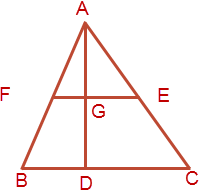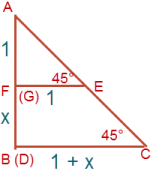Question 1 SSC-CGL 2018 June 4
[NOTE: only math questions solved]
Question: In a triangle ABC, the points F and E respectively on AB and AC sides are such that FE || BC and FE divide the triangle into two parts with equal area. If AD ⊥ BC and AD intersect FE at point G, then GD: AG =?

Method 1
- The result is independent of the type of triangle. So any triangle can be taken for verification.
- Take an isosceles right angled triangle such that AF = 1 as shown.

- Let $\displaystyle \overline {BF} = x$
- Given area of $\displaystyle \Delta \text{ABC} = 2 \times \Delta \text{AFE}$
- $\displaystyle \implies \frac12 \times (1 + x) \times (1 + x) = 2 \times \frac 12 \times 1 \times 1$
- Simplifying, $\displaystyle x = \frac{\overline{GD}}{\overline{AG}} = (\sqrt 2 - 1) : 1 \:\underline{Ans}$
Method 2
By similarity, if ratio of areas of two similar triangles is $\displaystyle R$, then their sides and altitudes are in the ratio $\displaystyle \sqrt R$
Given $\displaystyle \frac{\Delta ABC}{\Delta AFE} = 2$
So $\displaystyle \frac{AD}{AG} = \sqrt 2$
$\displaystyle \implies \frac{AG + GD}{AG} = \sqrt 2$
which gives $\displaystyle \frac{\overline{GD}}{\overline{AG}} = (\sqrt 2 - 1) : 1 \:\underline{Ans} $
Method 3
Because of similarity, $\displaystyle \frac{BC}{FE} = \frac{AD}{AG} \text{. . . (1)}$
Now, $\displaystyle \Delta ABC = 2 \times \Delta AFE$
$\displaystyle \implies \frac12 \overline{BC} \times \overline {AD} = 2 \times \frac12 \times \overline {FE} \times \overline{AG}$
$\displaystyle \implies \frac{BC}{FE} = 2 \times \frac{AG}{AD}$
Substituting by (1), $\displaystyle \frac{AD}{AG} = 2 \times \frac{AG}{AD}$
$\displaystyle \implies \frac{AD}{AG} = \sqrt 2$
$\displaystyle \implies \frac{AG + GD}{AG} = \sqrt 2$
which gives $\displaystyle \frac{\overline{GD}}{\overline{AG}} = (\sqrt 2 - 1) : 1 \:\underline{Ans} $

This Blog Post/Article "Question 1 SSC CGL 2018 June 4 Shift 1" by Parveen (Hoven) is licensed under a Creative Commons Attribution-NonCommercial-ShareAlike 4.0 International License.
Updated on 2020-02-07. Published on: 2020-01-14
